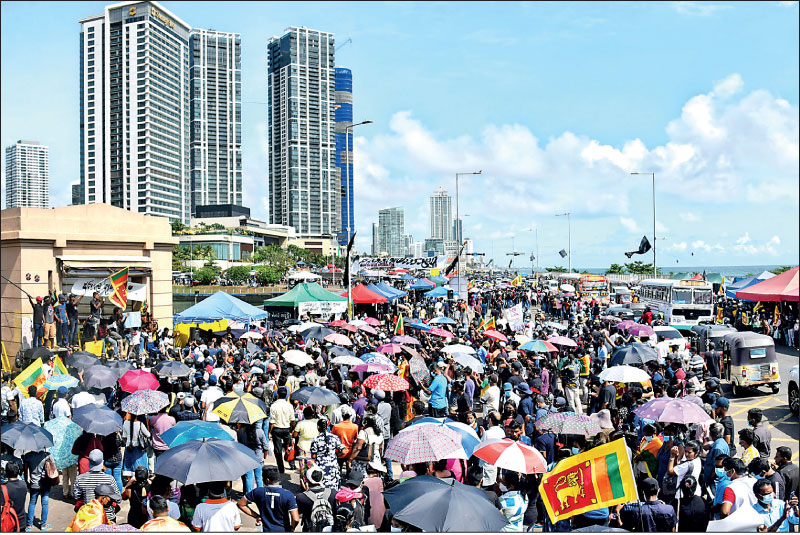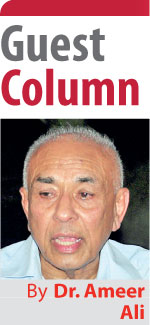Monday Apr 21, 2025
Monday Apr 21, 2025
Wednesday, 1 June 2022 01:30 - - {{hitsCtrl.values.hits}}

GR’s previous instructions to the police not to invade and disturb the peaceful existence of Gotagogama, and RW’s cunning public statement to support Aragalaya’s demand for Gota-Go-Home are measures intended to cause disillusionment among protestors, dissipate them and ultimately end with kindness the struggle for systemic change
 The core demand of Aragalaya is to bring about systemic change in the country’s political governance and economy. “Gota-Go-Home” and “No 225” are only means to that end. Although there had been widespread support for the core demand especially within the intelligentsia, civil societies and even sections of the media and Sangha, yet, during the last few weeks, and since the resignation of the previous prime minister, a counter struggle seems to be on foot led by the old guards to preserve the status quo.
The core demand of Aragalaya is to bring about systemic change in the country’s political governance and economy. “Gota-Go-Home” and “No 225” are only means to that end. Although there had been widespread support for the core demand especially within the intelligentsia, civil societies and even sections of the media and Sangha, yet, during the last few weeks, and since the resignation of the previous prime minister, a counter struggle seems to be on foot led by the old guards to preserve the status quo.
The so-called All-Party Government is the product of that struggle, and the proposed 21A drafted by Prime Minister Ranil Wickremesinghe (RW) also reflects that desire. Unless the core demand of Aragalaya is met, chances of achieving economic progress and political stability would be minimal.
A pernicious system
When Sri Lanka gained political independence in 1948, it inherited the Westminster model of parliamentary democracy with party system. The 1947 Constitution introduced a bicameral legislature with other safeguards to prevent the rise of ethnic-based majoritarian rule. Within a few decades however, that is exactly what happened and Sri Lanka effectively became an ethno-nationalist democracy founded on an ideology of Sinhala-Buddhist Majoritarianism (SBM). That majoritarian rule systematically became tyrannous leading ultimately to a civil war, the cost of which set the process for the country’s economy to go bankrupt.
SBM ideology was theoretically rationalised on grounds of mytho-history and an assumed fear of minorities. SBM to thrive needed an enemy and that enemy was artificially manufactured from time to time. Practically every government that came into power since 1950s was the product of SBM which, like a magnet, swung the votes of innocent Sinhala-Buddhist voters to elect populist leaders championing the cause of that ideology. What was pernicious about SBM was the leverage it provided to unscrupulous and ambitious politicians who advanced their own private agendas and interests at the expense of the people, and then to exploit Buddhism to get exonerated form their crimes and misdeeds.
While voters remained mesmerised by promises of prosperity, misrule and mismanagement were allowed to become systemic, which eventually sapped the vitality of parliamentary democracy. As a result, society became stratified and remained split ethnically, linguistically and religiously; communalism flourished; economic growth and development turned spasmodic at best; income and wealth distribution skewed increasingly in favour of a few; and, the whole country became treated like a pariah internationally. Parties and personalities in power did change almost regularly, but the ideology of SBM remained a permanent fixer.
Economic mismanagement, scandalous financial waste and loot, political crimes and blatant disregard to human rights reached their acme during the regime of the Rajapaksas. They not only drained the economy of its substance, but also for the first time in Sri Lanka’s history, caused starvation and malnutrition to visit hundreds of thousands of ordinary households. It was that alarming scarcity of food in combination with shortages of essentials including medicine that finally awakened the young generation of educated Sinhala-Buddhist men and women and made them realise that the politico-economic system built on the edifice of SBM is pernicious and self-destructive and therefore demanded an end to it.
Their awakening and realisation culminated in the Aragalaya, which meant not a revolution in its chaotic and violent image, but a peaceful agitation with unwavering determination to exert pressure upon the ruling elite to turn away from that pernicious system and its seven-decade-old politico-economic trajectory. In essence, it meant the demise of SBM, and along with it, other ethno-religious ideologies that arose to counter SBM. Soon, the Aragalaya started by the Sinhala-Buddhist youth attracted their counterparts among minority communities and transformed it into a national struggle for systemic change. Aragalaya holds promises for a truly democratic and egalitarian polity in future Sri Lanka.
In sum, the core demand of the younger generation hit the right nerve in the country’s body politic. Practically every piece of publication appeared in this journal and elsewhere supported that call, and academists, journalists, civil right groups and progressive thinkers offered multiple ways of realising its objective without violence. Surprisingly, even among conservative political parties there were a few who added their own voice of support to that change.
In spite of all that, what is happening now in the Parliament is a desperate attempt in the name of speedy economic revival and patriotism to preserve the status quo – not in the belief that it would bring “prosperity and splendour” at any time in the future, but to find, firstly, sufficient time to protect and provide escape routes to the culprits whose calculated loot and mismanagement brought ruination to the country, and secondly to maintain the critical role of SBM as the permanent fixer.
On the first, information is circulating with denial that one of the Maldivian leaders is busy brokering deals with the Rajapaksas for their asylum in that tourist paradise. It is becoming clear by the day that there is little resolve and preparation in the All-Party Government of RW to produce before law the entire previous leadership, which played a key role in recent violence and more than that for their reckless economic mismanagement. And on the second, President GR’s selection of ministers to the new cabinet along with ministerial secretaries speaks volumes of his commitment to SBM. Will a man who came to power championing that ideology and made public commitment to protect it at all cost ever surrender it for another?
Rearguard action
The so-called All-Party Government appointed by GR and led by his adjutant Prime Minister RW – an election loser who should have been brought before the law for his role in the infamous bond scandal and in the macabre Easter incident during Yahapalana Government – with an expected 25-member cabinet, all picked from the existing pack of 225, is a calculated ploy to frustrate the Aragalaya and retain the status quo. GR’s previous instructions to the police not to invade and disturb the peaceful existence of Gotagogama, and RW’s cunning public statement to support Aragalaya’s demand for Gota-Go-Home are measures intended to cause disillusionment among protestors, dissipate them and ultimately end with kindness the struggle for systemic change.
According to the SJB leader Sajith Premadasa, RW’s proposed 21A to disempower the executive president appears to be doing the opposite. Parliamentarians who have jumped already and are prepared to jump in future from SJB, SLFP, UNP and the so-called independents, in support of RW’s achcharu government, all stand to benefit from the existing system. There are plenty of SMB demagogues among them who would champion its cause when an election is declared. These turncoats would at least wish to continue with the existing system until their term of office ends in 2024.
Therefore, the All-Party Government is a conspiratorially devised political artefact intended to rebuff the aspirations of an awakened generation. Incidentally and surprisingly, even the former President Chandrika Kumaratunga, in her recent interview with Indian journalist Karan Thapar on her proposals for a change in governance, left this ideology totally unreviewed. These are the enemies of systemic change. What then is the alternative?
Friends of systemic change
RW’s achcharu government cannot last long partly because of its built-in instability and partly because it has no structural plan to set the economy on a sustainable growth path. With the flow of economic and financial assistance from friendly countries, and from international entities such as IMF, WB, ADB and so on, some of the immediate difficulties faced by the nation may be met and that too only to a limited extent.
This amount of limited assistance however, would have flowed into the country even without RW’s effort, because Sri Lanka is so strategically positioned in the context of Indian Ocean geopolitics that the world powers could not afford to watch it descending to anarchy through bankruptcy. But drawing and implementing a structural plan is a long-term affair that needs a stable government supported by the majority of people. That cannot be accomplished without a general election.
It is estimated that almost two-thirds of voters in Sri Lanka are below 40 years of age and more than 50% of them are women. Aragalaya, which is gender balanced and reckoned to have won the support of nearly 85% of the population, undoubtedly represents that majority. In the next parliamentary elections therefore, their votes would decide the winner. But so far and quite wisely, Aragalaya had remained apolitical. But can it remain so indefinitely given the rearguard action from the old system?
On the key demand for systemic change there seems to be total affinity between the new generation and the three progressive groups, JVP, NPP and FSP. However, the problem seems to be within the trio, which still has to agree on a common platform and plan of action to take the youngsters along with them. Fighting over ideological finer points is a historic past time among progressives. The country cannot afford that luxury at the moment. Sooner the trio understand this greater need, form a broad coalition, take the new generation with it and face the coming electoral battle, it would better for the country and its masses. JVP/NPP/FSP trio are the only friends of Aragalaya at present.
(The writer is attached to Murdoch Business School, Murdoch University, Western Australia.)
Discover Kapruka, the leading online shopping platform in Sri Lanka, where you can conveniently send Gifts and Flowers to your loved ones for any event including Valentine ’s Day. Explore a wide range of popular Shopping Categories on Kapruka, including Toys, Groceries, Electronics, Birthday Cakes, Fruits, Chocolates, Flower Bouquets, Clothing, Watches, Lingerie, Gift Sets and Jewellery. Also if you’re interested in selling with Kapruka, Partner Central by Kapruka is the best solution to start with. Moreover, through Kapruka Global Shop, you can also enjoy the convenience of purchasing products from renowned platforms like Amazon and eBay and have them delivered to Sri Lanka.
Discover Kapruka, the leading online shopping platform in Sri Lanka, where you can conveniently send Gifts and Flowers to your loved ones for any event including Valentine ’s Day. Explore a wide range of popular Shopping Categories on Kapruka, including Toys, Groceries, Electronics, Birthday Cakes, Fruits, Chocolates, Flower Bouquets, Clothing, Watches, Lingerie, Gift Sets and Jewellery. Also if you’re interested in selling with Kapruka, Partner Central by Kapruka is the best solution to start with. Moreover, through Kapruka Global Shop, you can also enjoy the convenience of purchasing products from renowned platforms like Amazon and eBay and have them delivered to Sri Lanka.